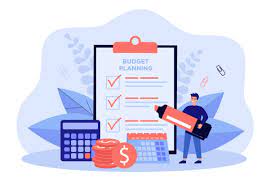Creating a budget is a fundamental skill that lays the foundation for financial success. It empowers individuals to take control of their money, allocate resources effectively, and achieve their financial goals. In this article, we will explore the art of creating a budget, step-by-step, and provide valuable insights and tips to help you manage your finances with confidence.

Step 1: Assess Your Income and Expenses
To create an effective budget, begin by thoroughly understanding your income and expenses. Follow these key steps:
- Calculate Your Income: Determine your total monthly income, including salary, bonuses, freelance work, and any other sources of income.
- Track Your Expenses: Carefully analyze your expenses for the past few months. Categorize them into fixed expenses (such as rent, utilities, loan payments) and variable expenses (such as groceries, entertainment, dining out). Utilize bank statements, receipts, and expense tracking apps to gather accurate data. [ Use – Receipt Jar ]
Step 2: Set Clear Financial Goals
Establishing financial goals is crucial as they provide direction and motivation for budgeting effectively. Consider short-term goals (such as paying off debt, building an emergency fund) and long-term goals (such as buying a house, retirement planning). Align your budget with these objectives to stay focused and motivated.
Step 3: Differentiate Between Needs and Wants
To create a realistic budget, it’s essential to differentiate between needs and wants. Needs are essential expenses required for survival, security, and well-being, while wants are discretionary expenses. Prioritize your needs and allocate funds accordingly. Be mindful of excessive spending on wants and find ways to reduce non-essential expenses.
Step 4: Create Categories and Allocate Funds
Now it’s time to allocate funds to different expense categories. Here are some common categories to consider:
- Fixed Expenses: Include rent/mortgage payments, utilities, insurance premiums, loan payments, and subscriptions.
- Variable Expenses: Allocate amounts for groceries, transportation, entertainment, dining out, clothing, and personal care.
- Savings and Investments: Prioritize savings by allocating a portion of your income towards emergency funds, retirement accounts, or other investment vehicles.
Step 5: Implement Tracking and Review
Creating a budget is not a one-time task; it requires ongoing monitoring and review. Use budgeting tools or apps to track your income and expenses [ Receipt Jar ]. Regularly review your budget to ensure you stay on track and make adjustments as needed. This practice will help you identify areas of overspending or potential savings opportunities.
Step 6: Embrace Flexibility and Adaptability
Life is full of surprises, and unexpected expenses can arise. Incorporate flexibility into your budget to accommodate unforeseen circumstances. Set aside a contingency fund for emergencies and be prepared to adjust your budget when necessary. Adaptability is key to maintaining financial stability.
Step 7: Seek Professional Guidance
If you find budgeting challenging or need assistance in fine-tuning your financial plan, consider consulting a financial advisor. They can provide personalized advice, help optimize your budget, and provide strategies to meet your specific financial goals.
Conclusion
Creating a budget is an art that empowers you to take control of your financial destiny. By assessing your income and expenses, setting clear goals, differentiating needs from wants, allocating funds wisely, tracking your progress, and staying flexible, you can master the art of budgeting and pave the way to financial success. Embrace the power of budgeting and embark on a journey of financial empowerment today.


2 Responses